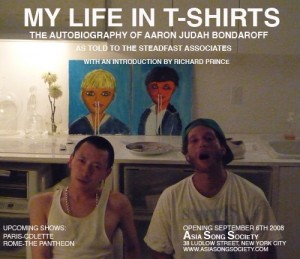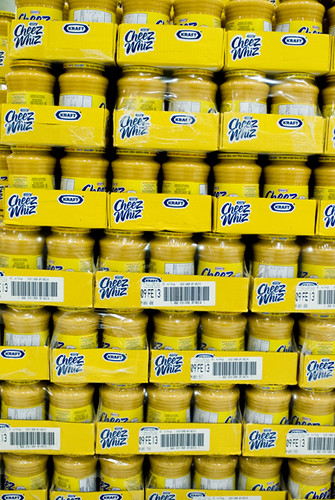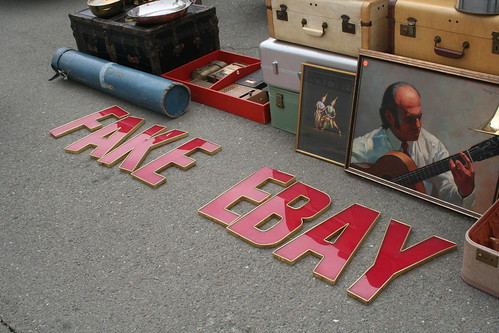I’m not even going to try to explain how I came upon this, but have you ever wondered: Is there a blog about pince-nez* spectacles — one that “provides advice and debunks myths” regarding this style of eyewear?
The answer is: Of course there is.
And it’s quite informative! The best post, I think, is this one.
[*Pronunciation audio file here.]

Originally uploaded by ribena.
The Economist has a very interesting article on one of my favorite subjects: Camo. (Here’s a about camo from 10/17/04).) It’s about new developments and technology in the camo world. Check Consumedthis out:
“Adaptive” camouflage that changes rapidly in response to the environment is also in the works. TNO, a Dutch defence contractor based in Soesterberg, is using thin, textile-like plastic sheets embedded with light-emitting diodes (LEDs). A small camera scans the environment, and the colours and patterns displayed on the sheet are changed accordingly. The material is not yet flexible enough to be worn comfortably by soldiers, but it is being tested in Afghanistan with Saab Barracuda, a Swedish maker of camouflage equipment.
Pieter Jacobs, TNO’s chief technologist, says the defence ministries of Canada, Germany and the Netherlands, which have funded the development of the technology, consider such “chameleon” sheeting to be an urgent requirement. Maarten Hogervorst, a vision neuroscientist at TNO, says its performance is formidable. A tank draped with the sheeting and parked in front of a grassy slope displays an image of grass on its exposed side, for example.
Well if this comes to pass in a wearable form it would definitely cross over to fashion applications, right? Maybe you could have a shirt that changed colors to complement the surroundings!
Anyway, the article also gets into camo’s opposite number: Detection technlogies. Interesting stuff.
Speaking of stuff happening in New York: I was interested in this from Deborah Solomon’s Q&A with Harry Shearer in the NYT Magazine:
This Friday, you have a show opening at the Susan Inglett Gallery in New York. Are you a visual artist of some kind? I collect video footage of political and media types who are always yakking at us on television — the footage I collect is of them not talking. The project is called “Non-Talking Heads.”
The gallery’s site says:
Well-known personalities from politics and the media are caught here in the moments before “going live”. Each portrait hangs silent, still, cheek to jowl in Shearer’s living, breathing portrait gallery.
I’m not sure what the presentation will be from either of these bits, but I’m picturing a bunch of TV screens with silent video loops, and I think it sounds fantastic. I believe I have mentioned before Shearer’s “Silent Debates” series on My Damn Channel. That’s here, link goes straight to video.
The gallery is at 522 West 24 Street, New York. It opens Friday night, per above, but normal hours are Tue-Sat 10 to 6, and personally I’d rather look at these in silence, not at a party.
A friend of the site has asked that I tell you about Interesting New York, an event this coming Saturday, September 13. It lasts all day and as I understand it consists of a whole bunch of short presentations by a variety of people on a variety of subjects, selected for level of “interesting”ness. The supremely annoying site for this event is here; the less annoying rundown of presenters is here. A few other friends of Murketing turn out to be on that list — but enough about that.
The one that caught my attention is The Marketer Who Went Off Consumption. That would be Gaurav Mishra, who writes: “On March 23, I decided to go off consumption for a year to understand an increasingly important subculture whose members refuse to define their identity by buying things.” Here is Mishra’s blog — which turns out to be a book in progress. I was a little surprised to see the top post is about “How to market to consumers who define themselves by their anti-consumerism.”
So I suppose he’s the marketer who went off consumption … in order to become a better marketer? I’m not sure how I feel about that.
But … there’s some other interesting stuff in the blog, which I’ll have to examine more closely a little later, and if you live in New York and want to pay $35 to hear from him and the other presenters at this event, I’d be curious to hear what you think.
Interesting New York
Saturday, September 13, 2008
10:00AM to 6:00PM.
The Katie Murphy Amphitheater at FIT
7th Avenue at 27th Street (Building D), New York City
Outstanding brands-in-the-news cameo for the Coca Cola company today, in the WSJ’s tick-tock story about the Fannie/Freddie takeover: The action involving Henry Paulson and other officials culminated in “a marathon session over the Labor Day weekend, fueled in part by Diet Coke and Coke Zero.”
Would you feel better or worse if it was Red Bull? Diet Red Bull? Starbucks lattes?
Okay, how about Sparks?
 GONE SOUR
GONE SOUR
The sweet benefits of a clearly defined rival
This week in Consumed, a look at Red Mango’s rivalry with Pinkberry.
It’s a cliché that the fight for survival brings out the best in business rivals, but a clear rivalry is also useful to consumers — it’s something to latch on to, an opportunity to take sides. Many Red Mango locations are in conspicuously close proximity to a Pinkberry. Kim claims this is a “coincidence,” owing more to his own chain’s real estate research than to any provocation. But read the reviews on Yelp.com of the Pinkberry and Red Mango locations that more or less face each other on Bleecker Street in New York. The Red Mango at 182 Bleecker registers four stars out of five, based on 74 reviews — many of which reference Pinkberry directly.
Read the column in the September 7, 2008 issue of the New York Times Magazine, or here.
Consumed archive is here, and FAQ is here. The Times’ Consumed RSS feed is here. Consumed Facebook page is here.
To make a point about Consumed that you think readers of The Times Magazine would be interested in: “Letters should be addressed to Letters to the Editor, Magazine, The New York Times, 620 Eighth Avenue, 6th Floor, New York, N.Y. 10018. The e-mail address is magazine@nytimes.com. All letters should include the writer’s name, address and daytime telephone number. We are unable to acknowledge or return unpublished letters. Letters may be edited for length and clarity.”
Actually I have no idea what this is, really. But I gather it’s tonight. I guess. Or something.
If I were in the area I’d have made an effort to find out. But I’m not, so I didn’t. If you go, or whatever, let me know.

That’s right, AntiFriday is on Saturday today. Here goes.
* Heart asked the GOP to stop using “Barracuda” as Sarah Palin’s de facto theme song — and the GOP promptly played it again after her convention speech. “I feel completely f—ed over,” Nancy Wilson says. She and sister Ann add: “Sarah Palin’s views and values in NO WAY represent us as American women. We ask that our song ‘Barracuda’ no longer be used to promote her image. The song ‘Barracuda’ was written in the late 70s as a scathing rant against the soulless, corporate nature of the music business, particularly for women.” Slate says the GOP may not need the band’s permission.
* Unplug Your Friends features a cute video intended to counter “screen addiction.” Specifically you can counter screen addition by joining/forming a Meet Up group — or (in a classic murketing tactic) emailing your friends to get them involved in Meet Up. And I must disclose that this came to my attention because someone at Meet Up sent it to me. [Link goes straight to video]
* The Washington Post assesses retail signage that looks a lot like Barbara Kruger’s work. Guy responsible says it’s an “obvious homage.” Kruger doesn’t seem to care one way or the other. Writer Blake Gopnik concludes: “Sometimes — maybe even most of the time — the look of an image is itself the thing we care most about it. Its look is its crucial content. Its style is its meaning; it’s what gets distilled out of it, as the message we take home. When a real estate agent borrows Kruger’s look and leaves most of her ideas behind, he may be treating art the way most of us do.” [I’m a devoted WaPo Style page reader, but thanks also to Braulio for mentioning this.]
* And finally: E directs my attention to this video in which you “meet the graphic designer behind Hollywood’s most famous floating head movie posters.” Amusing. [Again, link goes straight to video.]
Posted Under:
Anti,
Artists,
Backlashing,
Murketing by Rob Walker on September 6, 2008
Comments Off on AntiFriday: Your weekly compendium of backlashes, dissent & critiques
Here, then, the third Q&A connected to artists I commissioned to create posters related to Buying In. This time it’s The Little Friends of Printmaking, who I believe I first heard of from Faythe Levine; then I checked out their site, and saw their work in person when I happened to be at Renegade Chicago a year or so ago. I was thrilled when they zithromax were willing to make a poster in connection with the Washington D.C. Buying In event (see below; there’s also a version of this poster that’s sort of like a “tour blank,” but more on that some other time).
As with F2 Design and Amy Jo, the other esteemed creators I was fortunate to enlist in my largely ego-driven cause, I asked The Little Friends of Printmaking if they’d be willing to do a Q&A here, and they said yes. Read on for their thoughts on working as a team; on getting applications from hopeful Brand Managers; on the inspiring effects of crippling student debt and no particular professional prospects; on the effect of so many poster-makers; on how their life is actually not that much like a sitcom; and on which of their cats is less helpful, among other topics.
Very briefly: The Little Friends of Printmaking are Melissa and JW Buchanan; they are based in Milwaukee; they make posters and art prints and illustration work and apparently even at least one toy. (Blog; Flickr stream.) And as you’ll see, they’re very funny.

Q: So you are a married couple who work together as Little Friends of Printmaking. At what point did you decide to take a team approach? And do you think it made it harder or easier to establish yourselves as Little Friends of Printmaking than as two separate artists? Do people ever think that you’re more of a company than two collaborating artists?
Melissa: We started working together when we were in school. We were both studying art at the University of Wisconsin in Madison, and we had met early on. I don’t know when exactly we started to work as a team, or if there was a specific project that made us want to pool our resources; I think it was a gradual extension of us working side by side. When you’re a printmaker the work goes much faster if you’re working with a buddy. That kind of relationship, where you help someone else print their work, that wasn’t unusual. What we did, collaborating from beginning to end, was unusual. Our professors didn’t really encourage us or even approve of our partnership, probably because it was harder to grade us as individuals. We made their lives 0.15% more complicated, which of course was unacceptable.
JW: It’s a big step to throw everything together into a partnership the way we did. Maybe we didn’t have the sense of propriety that other people had for their own work, or maybe we just liked each other’s work a whole lot. Who knows. As a team, we have had an easier time establishing ourselves in some respects. When you work under a name that isn’t your given name, or from under the umbrella of a collective, you kind of get to invent and define who you are as an artist without sounding too much like an idiot or an asshole.
It’s been much easier for us to promote our Little Friends projects because our names aren’t front and center. I don’t think we would have made it very far if we had to rely on reserves of self-confidence that we don’t have. We can hide behind the name, use it as a bully pulpit, whatever. It works for us. There’s still a lot of glamour attached to the idea of the artist as a genius with a singular vision—we don’t get any of that. We’re glamour-deficient. Please continue…

I have no further information. Via Hipster Runoff.




 "
"



 GONE SOUR
GONE SOUR

















 Kim Fellner's book
Kim Fellner's book  A
A